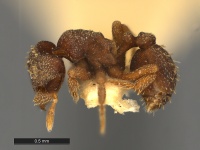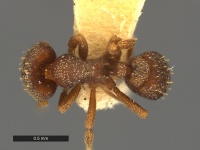Eurhopalothrix caledonica
| Eurhopalothrix caledonica | |
|---|---|

| |
| Scientific classification | |
| Kingdom: | Animalia |
| Phylum: | Arthropoda |
| Class: | Insecta |
| Order: | Hymenoptera |
| Family: | Formicidae |
| Subfamily: | Myrmicinae |
| Tribe: | Attini |
| Genus: | Eurhopalothrix |
| Species: | E. caledonica |
| Binomial name | |
| Eurhopalothrix caledonica Brown & Kempf, 1960 | |
The types, three workers, were collected separately in berlesate of rain forest leaf litter.
Identification
Keys including this Species
Distribution
Latitudinal Distribution Pattern
Latitudinal Range: -21.533333° to -21.533333°.
| North Temperate |
North Subtropical |
Tropical | South Subtropical |
South Temperate |
- Source: AntMaps
Distribution based on Regional Taxon Lists
Australasian Region: New Caledonia (type locality).
Distribution based on AntMaps
Distribution based on AntWeb specimens
Check data from AntWeb
Countries Occupied
| Number of countries occupied by this species based on AntWiki Regional Taxon Lists. In general, fewer countries occupied indicates a narrower range, while more countries indicates a more widespread species. |

|
Estimated Abundance
| Relative abundance based on number of AntMaps records per species (this species within the purple bar). Fewer records (to the left) indicates a less abundant/encountered species while more records (to the right) indicates more abundant/encountered species. |

|
Biology
|
Castes
Nomenclature
The following information is derived from Barry Bolton's Online Catalogue of the Ants of the World.
- caledonica. Eurhopalothrix caledonica Brown & Kempf, 1960: 220, figs. 44, 51 (w.) NEW CALEDONIA.
Unless otherwise noted the text for the remainder of this section is reported from the publication that includes the original description.
Description
Worker
Holotype: TL 2.9, HL 0.65, HW 0.73 (CI 112), scape L 0.36, greatest diameter of eye ca. 0.05, WL 0.73 mm.
Larger than Eurhopalothrix brevicornis and Eurhopalothrix australis, but with a similarly shaped head and much the same pattern of cephalic erect hairs. Also the following distinguishing characters:
1. Alitrunk with a distinct but broad and rather shallow metanotal groove; dorsal face of propodeum sloping posteriad, with a deep angular impression forming a step-like outline at its midlength as seen in lateral view.
2. Petiolar node as seen from side higher than long, rather narrowly rounded above; as seen from above, node much broader than long, with rounded sides and a nearly straight anterior border. Postpetiole reniform, not quite twice as wide as petiolar node, and nearly 2/3 as wide as widest part of gaster.
3. The small appressed hairs of the ground pilosity are a little less abundant than in australis over head and gaster; those on head are more or less obscured by matter adhering to the surface (a hardened secretion?).
4. The larger specialized hairs are clavate and erect to obliquely erect, much more slender than in australis, longer than in brevicornis. There are 16 of them on the head (the extra hair occurring beside each eye in australis is absent in the holotype and the two paratype workers of Eurhopalothrix caledonica). The alitrunk and both nodes completely lack larger specialized hairs, but the gaster bears about 24 short, caudally-inclined clavate hairs, most of which form 4 rough longitudinal rows, on the first tergite. Other clavate hairs on gastric apex and along a median strip on underside of gaster. Color medium reddish-brown, legs lighter.
Etymology
Holotype Museum of Comparative Zoologya worker, one of three taken separately in rain forest leaf litter berlesates from near Ciu, on the approach to Mt. Canala, 300 M. altitude (E. O. Wilson leg.), December, 1954. The two paratypes are the remaining workers, taken at this locality during January, 1955 MCZ. They are virtually identical with the holotype in size and form, though both have lost some hairs, apparently through rubbing. One has a narrower head (HL 0.65, HW 0.70 mm, CI 108).
References
- Brown W.L. Jr., Kempf W. W. 1960. A world revision of the ant tribe Basicerotini. Studia Entomologica. 3:161-250. (page 220, figs. 44, 51 worker described)
References based on Global Ant Biodiversity Informatics
- Brown W. L., Jr., and W. W. Kempf. 1960. A world revision of the ant tribe Basicerotini. Stud. Entomol. (n.s.) 3: 161-250.
- Jennings J. T., L. Krogmann, and C. Burwell. 2013. Review of the hymenopteran fauna of New Caledonia with a checklist of species. Zootaxa 3736(1): 1-53.
- Jourdan H., J. Konghouleux. 2005. Bilan entomologique des noyaux forestiers dits, S2 à S5, à Prony, définies par Goro Nickel SA. Rapport d'Expertise IRD / Goro Nickel SA, 15 pages.
- Jourdan H., and Joel Konghouleux. 2005. Bilan entomologique des noyaux forestiers dits, « S2 et S5 », à Prony, définies par Goro Nickel SA. IRD 16 pages
- Taylor R. W. 1980. Australian and Melanesian ants of the genus Eurhopalothrix Brown and Kempf - notes and new species (Hymenoptera: Formicidae). Journal of the Australian Entomological Society 19: 229-239.
- Taylor R. W. 1987. A checklist of the ants of Australia, New Caledonia and New Zealand (Hymenoptera: Formicidae). CSIRO (Commonwealth Scientific and Industrial Research Organization) Division of Entomology Report 41: 1-92.

